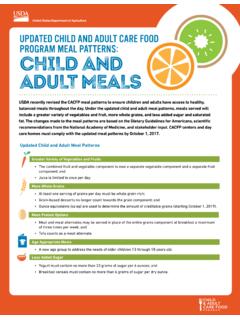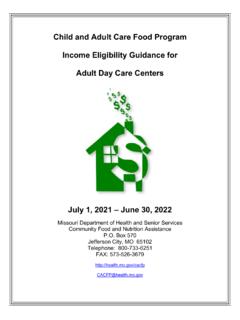Transcription of Child & Adult Care Food Program: Participation Trends 2017
1 February 2018 Child & Adult Car e food Program: Participation Trends 2017 food Research and Action Center CACFP Participation Trends 2017 About FRAC The food Research and Action Center (FRAC) is the leading national organization working for more effective public and private policies to eradicate domestic hunger and undernutrition. For more information about FRAC, or to sign up for FRAC s Weekly News Digest, visit For more information about CACFP, go to - care - food -program Acknowledgements This report was prepared by Randy Rosso and Geri Henchy.
2 Many thanks to the United States Department of Agriculture s food and Nutrition Service for providing the data used in this report. The CACFP data are preliminary. food Research and Action Center CACFP Participation Trends 2017 1 Child and Adult care food Program (CACFP) any low-income working parents rely on Child care and afterschool programs to provide a safe and healthy place for their children while they commute and work. By paying for nutritious meals and snacks for eligible children who are enrolled at participating Child care centers, day care homes and Head Start programs , the Child and Adult care food Program (CACFP) plays an important role in improving the quality of those programs and in making them more affordable for low-income parents.
3 CACFP is a well-documented success. Young children can receive up to two meals and a snack that meet USDA nutritional standards. Studies have shown that children in CACFP receive meals that are nutritionally superior to those served to children in Child care settings without CACFP. Children in participating institutions have higher intakes of key nutrients, fewer servings of fats and sweets, than children in non-participating care . Research cites Participation in CACFP as one of the major factors influencing quality care , reporting that 87 percent of the family Child care homes considered to be providing quality Child care participated in CACFP.
4 While the Child and Adult care food Program has several segments, the majority of CACFP participants are preschool-aged children attending participating family Child homes, Child care centers or Head Start programs . Depending on the type of program, eligibility is based either on the poverty status of the area or on the income of the enrolled children. Eac h year the food Research and Action Center (FRAC) analyzes CACFP Participation data for Child care centers and family Child care homes provided by the United States Department of Agriculture (USDA) for the United States as a whole and for each of the 50 states and the District of Columbia.
5 Key findings for fiscal year 20 17 include: Child care Centers Just over million children enrolled in Child care centers benefited daily from CACFP in fiscal year 2017 , a percent increase from fiscal year 2016. Nationally the number of Child care centers participating in CACFP declined slightly to 63,908 in fiscal year 20 17, a percent de crease from the previous year. Family Child care Homes In fiscal year 2017 , 75 6,947 low -income children attending family Child care homes relied on CACFP to provide healthy meals each day, essentially unchanged from fiscal year 2016.
6 Nationally 10 2,6 30 family Child care homes participated in CACFP in fiscal year 2017 , a percent decrease from the previous year. M The Impact of the CACFP Means Test As part of the reform of welfare undertaken in 1996, major changes in the way family Child care homes are reimbursed in the Child and Adult care food Program were mandated. A means test was instituted which effectively cut in half the federal reimbursement for meals and snacks for providers serving moderate-income children. These changes have had negative consequences that continue to affect the program.
7 Between 1996 and 20 17 the number of family Child care homes participating in CACFP dropped by percent, while the number of children served fell by 219 ,269 . This is in contrast to the growth of Child care centers, including Child care and afterschool programs , usi ng CACFP over that time. During the same 20 -year period, the Participation of centers in CACFP grew by 90 .0 percent and the number of children served by those centers grew by just over million. 050,000100,000150,000200,000250,0001986 1988 1990 1992 1994 1996 1998 2000 2002 2004 2006 2008 2010 2012 2014 2016 Number of Family Child care Homes and Child care CentersHomesCenters277309357414481542612 6687297667777757517447387177086936876716 3862762761359558256955153752551148401002 003004005006007008009001986 1988 1990 1992 1994 1996 1998 2000 2002 2004 2006 2008 2010 2012 2014 2016 MillionsNumber of Meals (in Millions)
8 Served by Family Child care Homes, FY 1986 -FY 2017 Table 1 Change in the Number of Child care Centers, FY 1997 to FY 2017 StateTotal Centers FY 1997 Total Centers FY 2017 Number ChangePercent ChangeRank (Percent Change) % % %47 Arkansas3971, %6 California3,5177,7954, % % % %3 District of %8 Florida1,3304,5383, %4 Georgia1,0391, % % %9 Illinois1,2722,4321, %19 Indiana7551, % % %42 Kentucky8041, % % %50 Maryland3991, % %44 Michigan9471, % % %13 Missouri6121, % % % %1 New %32 New Jersey9371, %43 New %30 New York2,3744,2511, %26 North Carolina1,5632, %33 North %21 Ohio1,4261, % % %35 Pennsylvania1,5093,0801, %17 Rhode %16 South %24 South %31 Tennessee6961, %12 Texas1,7756.
9 2824, % % %7 Virginia6851, %22 Washington8311, %29 West % % %23US34,04963,90829, %Source: FRAC analysis of administrative CACFP data provided by : US totals include Guam, Puerto Rico, and the Virgin 2 Change in the Number of Child care Centers, FY 2016 to FY 2017 StateTotal Centers FY 2016 Total Centers FY 2017 Number ChangePercent ChangeRank (Percent Change) % % %42 Arkansas1,2271, %49 California7,5307, % % % %7 District of %2 Florida4,5054, %26 Georgia2,4291, % % %10 Illinois2,3702, %19 Indiana9821, % % %29 Kentucky1,0171, % % %18 Maryland1,3501, % %28 Michigan1,5371, % % %5 Missouri1,2291, % % % %3 New %23 New Jersey1,3451, %44 New %15 New York4,4654, %39 North Carolina2,2302, %27 North %13 Ohio1,8961, % % %47 Pennsylvania3,3183, %43 Rhode %37 South %11 South %33 Tennessee1,8451, %50 Texas6,3466.
10 % % %6 Virginia1,3661, %46 Washington1,2891, %20 West % % %16US65,10563,908-1, %Source: FRAC analysis of administrative CACFP data provided by : US totals include Guam, Puerto Rico, and the Virgin 3 Change in the Average Daily Attendance of Child care Centers, FY 1997 to FY 2017 StateADA Centers FY 1997 ADA Centers FY 2017 Number ChangePercent ChangeRank (Percent Change)Alabama22,15455,43733, %16 Alaska4,5258,5454, %34 Arizona31,94532, %51 Arkansas14,73857,77743, %7 California143,497484,308340, %8 Colorado18,71336,20217, %30 Connecticut9,36617,6498, %35 Delaware6,17118,08311, %12 District of Columbia4,17430,28126, %2 Florida70,187285,515215, %5 Georgia65,399126,15860, %31 Hawaii7,6169,6282, %49 Idaho3,37510,1236, %10 Illinois55,155114,88859, %26 Indiana27,86568,68140, %18 Iowa16,97728,85311, %43 Kansas16,97924,6887, %45 Kentucky33,66860,42126.















